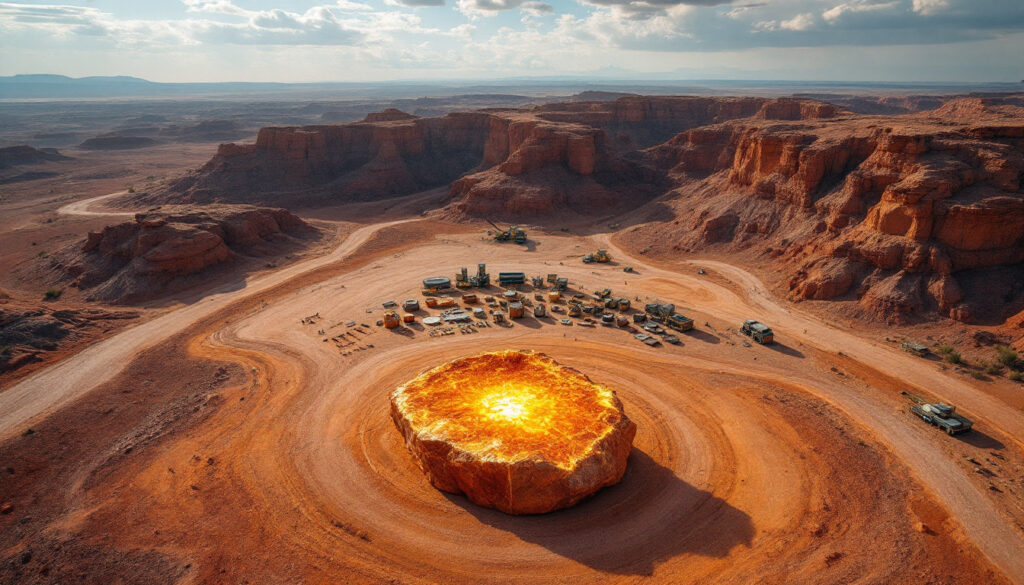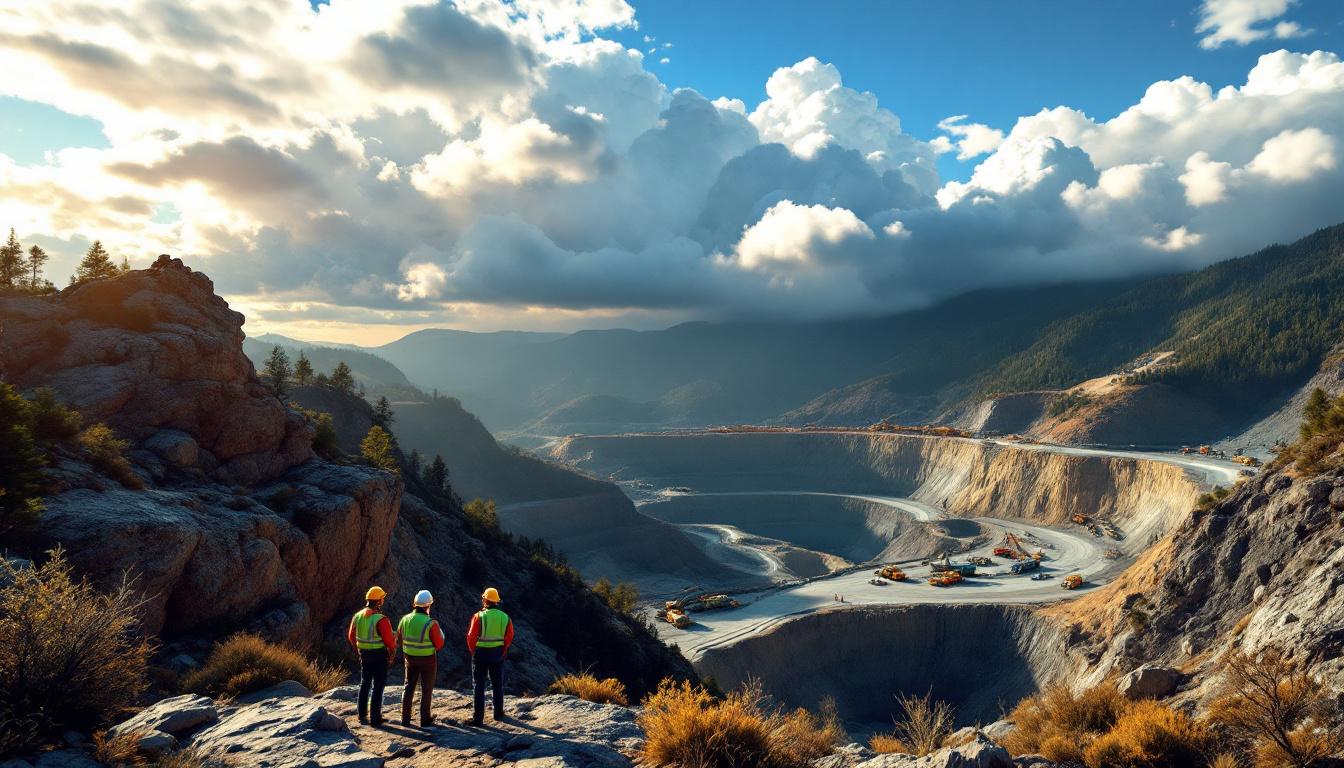Why Has a US Judge Blocked the Rio Tinto-BHP Copper Mine Land Exchange?
The recent decision by US Federal Judge Steven Logan to block a critical land exchange for the Resolution Copper project marks another significant setback in a decades-long development struggle. On May 9, 2025, the 18-page ruling halted the transfer of federally protected land that would have allowed Rio Tinto and BHP to advance what could become one of America's most productive copper mines. This decision represents the latest chapter in an ongoing conflict between resource development and indigenous rights that continues to shape America's critical minerals.
Understanding the Resolution Copper Project
The Resolution Copper project represents a potentially transformative development in America's domestic copper production capabilities. Located near Superior, Arizona, this proposed underground mine targets one of North America's largest undeveloped copper deposits, estimated to contain approximately 1.78 billion metric tons of copper ore.
The joint venture between mining giants Rio Tinto (55% ownership) and BHP (45% ownership) has been in development since 1995, with over $2 billion already invested in exploratory work, environmental studies, and preliminary infrastructure. The project's strategic importance is difficult to overstate: at full production, Resolution could supply approximately 25% of America's domestic copper needs for 40+ years.
"The Resolution deposit represents a multigenerational opportunity to deliver the copper essential to electric vehicles, renewable energy infrastructure, and advanced technologies," said Rio Tinto Copper Chief Executive Bold Baatar in a statement following the ruling. "We remain committed to finding a path forward that respects all stakeholders."
The mining plan utilizes block cave mining, an advanced underground technique requiring shafts extending approximately 7,000 feet below the surface. This method minimizes surface disturbance compared to traditional open-pit mining but requires substantial upfront infrastructure development.
What's at Stake in This Mining Land Dispute?
The Contested Land Exchange
At the heart of the legal dispute is a congressionally mandated land exchange included in the 2014 National Defense Authorization Act. The provision directed the US Forest Service to trade 2,422 acres of federally managed land in the Tonto National Forest for 5,344 acres of private land owned by Resolution Copper.
The contested area includes Oak Flat (Chi'chil Biłdagoteel), a site sacred to several Native American tribes, particularly the San Carlos Apache. This plateau contains significant religious, cultural, and historical sites that would be irreparably damaged by the proposed mining operation, which would eventually create a subsidence crater approximately 2 miles wide and up to 1,000 feet deep.
Judge Logan's ruling specifically questioned whether proper procedures were followed under the National Historic Preservation Act (NHPA), which requires thorough consultation with tribal nations regarding impacts to cultural resources. The temporary injunction will remain in effect while a related case proceeds through the Supreme Court.
Native American Opposition and Cultural Preservation
"Oak Flat is our Mount Sinai," explained San Carlos Apache Tribal Chairman Terry Rambler in court documents. "This is where our Creator speaks to us. This land exchange is not just about mining—it's about our religious freedom and cultural survival."
The Apache Stronghold, a nonprofit organization dedicated to protecting Oak Flat, has led the legal challenges against the land exchange. Their case hinges on religious freedom protections, arguing that the destruction of Oak Flat would constitute a "substantial burden" on Apache religious practice under the Religious Freedom Restoration Act (RFRA).
The area contains numerous culturally significant features, including:
- Ancient burial grounds dating back centuries
- Traditional gathering sites for medicinal plants
- Locations for coming-of-age ceremonies
- Spiritual sites where prayers and offerings are made
- Ancient petroglyphs and archaeological remains
The indigenous opposition to Resolution Copper extends beyond the Apache tribe. The Inter Tribal Association of Arizona, representing 21 federally recognized tribes, has consistently voiced concerns about the project's cultural and environmental impacts.
How Does This Ruling Impact Copper Development Plans?
Immediate Consequences for Project Development
Following Judge Logan's ruling, Resolution Copper announced suspension of shaft-sinking operations that had been scheduled to begin in July 2025. The company will continue environmental baseline monitoring and community programs but has placed major development activities on hold pending legal resolution.
Financial consequences are already evident. Within days of the ruling, share prices for both Rio Tinto and BHP declined approximately 3.4% and 2.8% respectively on the Australian Securities Exchange. Analysts from Goldman Sachs estimate the delay could cost the companies $45-60 million per quarter in maintenance and legal expenses while pushing the potential production timeline from 2029 to beyond 2032.
"This represents more than a procedural setback," noted mining analyst Jessica Horowitz of BMO Capital Markets. "The ruling creates fundamental uncertainty about whether the project can proceed in its current form. We're potentially looking at years of additional delays."
Resolution Copper had previously announced plans to employ approximately 3,700 workers during peak construction and 1,500 permanent staff once operational. The Arizona Mining Association estimates the project would generate $63.4 billion in economic impact over its lifetime, with approximately $20 billion in tax revenue for various levels of government.
Market and Industry Implications
The Resolution Copper delay occurs amid growing recognition of copper's critical importance to energy transition technologies. The International Energy Agency projects copper demand will increase 25% by 2030, driven by electric vehicles, renewable energy, and grid infrastructure.
"The US faces a significant copper supply deficit at precisely the wrong moment historically," explains commodities strategist Michael Widmer of Bank of America. "Each EV requires approximately 85kg of copper compared to 23kg for conventional vehicles. Without major new domestic sources like Resolution, American manufacturers will face increased reliance on imports from Chile, Peru, and potentially less stable jurisdictions."
The United States currently imports approximately 35% of its copper, but that percentage is projected to increase significantly as older domestic mines deplete their reserves and demand accelerates. Resolution's potential production of 120,000 tons annually would reduce import dependency while creating domestic supply chain resilience.
Market responses to the ruling have been measured but significant:
| Impact Area | Short-Term Effect | Long-Term Implication |
|---|---|---|
| Copper Price | +1.2% week-over-week | Potential support for higher copper price predictions |
| US Mining Investment | $840M in delayed capital expenditure | Increased regulatory risk perception |
| Import Reliance | No immediate change | Projected 8-12% increase in import dependency by 2030 |
| Supply Chain Security | Minimal impact | Reduced resilience against future disruptions |
What Legal Pathways Remain for the Resolution Copper Project?
The Supreme Court's Role in the Dispute
The legal future of Resolution Copper now rests largely with the Supreme Court, which is considering a separate but related challenge in Apache Stronghold v. United States (Docket No. 24-1234). This case directly addresses whether the land exchange violates the Religious Freedom Restoration Act and the First Amendment's protection of religious freedom.
The Supreme Court agreed to hear the case in March 2025, with oral arguments expected in October. Legal experts suggest three potential outcomes:
- Uphold lower court rulings that found no substantial burden on religious practice, allowing the land exchange to proceed pending additional consultation
- Determine that RFRA protections apply, effectively blocking the current exchange mechanism
- Remand with specific guidance on proper consultation procedures and religious freedom standards
"This case could establish precedent far beyond mining," explains Sandra Little Feather, professor of Native American Law at Arizona State University. "It tests whether Congress can transfer sacred sites to private companies despite religious freedom protections. The implications for tribal sovereignty and cultural protection nationwide are enormous."
Possible Regulatory and Legislative Solutions
Despite the legal setbacks, multiple pathways remain for Resolution Copper to advance. The Trump administration has signaled potential executive action to accelerate the project, citing critical mineral security concerns. Options being explored include:
- Modified land exchange terms that preserve access to certain cultural sites
- Enhanced tribal consultation with binding commitments for cultural resources protection
- Legislation clarifying consultation requirements while reaffirming the exchange mandate
- Alternative mine design reducing surface impacts to Oak Flat
Resolution Copper spokesperson Sarah Miller noted: "We believe there are solutions that can respect indigenous cultural values while delivering this critical resource. We're committed to meaningful dialogue with all stakeholders to find that balance."
The company has already revised its mining plan several times to reduce environmental impacts, including water conservation measures that would recycle 95% of process water and enhanced monitoring of groundwater impacts in the drought-prone region.
How Does This Case Reflect Broader Resource Development Challenges?
Balancing Economic Development and Indigenous Rights
The Resolution Copper conflict exemplifies the growing tension between mineral demands for clean energy technologies and indigenous rights protection. Similar disputes have emerged across North America:
- The Thacker Pass lithium project in Nevada faces opposition from multiple tribes concerned about cultural sites
- Twin Metals Minnesota copper-nickel project near the Boundary Waters has drawn resistance from the Fond du Lac Band of Lake Superior Chippewa
- Donlin Gold in Alaska confronts concerns from Yup'ik communities regarding subsistence resources
"We're witnessing a fundamental shift in how these conflicts are addressed," explains Dr. Robert Wilson, professor of indigenous environmental justice at the University of Arizona. "Courts increasingly recognize that proper consultation isn't simply a procedural box to check but requires meaningful engagement with tribal concerns and potential project modifications."
International standards have evolved significantly, with the United Nations Declaration on the Rights of Indigenous Peoples establishing principles of Free, Prior and Informed Consent (FPIC) that go beyond traditional consultation requirements. While not legally binding in the US, these standards increasingly influence corporate policies and risk assessments.
Environmental Considerations and Sustainability
Beyond cultural impacts, the Resolution Copper project raises significant environmental questions specific to the American Southwest. The region faces unprecedented drought conditions, with the Colorado River Basin experiencing its driest 22-year period in 1,200 years.
Resolution's projected water usage—approximately 775,000 acre-feet over the 40-year life of mine—has raised concerns among environmental groups and local communities. The company has responded with commitments to:
- Utilize treated effluent water from nearby communities where possible
- Implement state-of-the-art tailings dewatering systems
- Partner with watershed enhancement projects
- Monitor seismic activity related to block cave mining
- Develop comprehensive dust management protocols
The Environmental Impact Statement completed in 2021 identified potential impacts to 14 threatened or endangered species within the project area, including the western yellow-billed cuckoo and the narrow-headed garter snake. Resolution has committed to conservation measures, including funding habitat restoration projects throughout the region.
What Perspectives Should Be Considered in This Complex Case?
Economic Benefits vs. Cultural Preservation
The Resolution Copper debate fundamentally centers on competing value systems and priorities. Economic analyses highlight significant benefits:
- 3,700 construction jobs at peak development
- 1,500 direct permanent jobs averaging $102,000 annual salary
- 2,200 indirect jobs in support industries
- $63.4 billion total economic impact over 40+ years
- $20 billion in tax revenue generation
These tangible economic benefits must be weighed against cultural values that resist monetary quantification. The San Carlos Apache Tribe maintains that certain spiritual practices can only be performed at specific locations within Oak Flat, making those sites literally irreplaceable.
"This isn't about compensation or mitigation," explains Wendsler Nosie Sr., former chairman of the San Carlos Apache Tribe and founder of Apache Stronghold. "You cannot relocate spiritual connections that have existed for thousands of years. Once destroyed, they are gone forever."
National Resource Security Considerations
The Resolution conflict also intersects with growing concerns about critical mineral supply chains and national security. In 2022, the US Geological Survey designated copper as a critical mineral due to its essential role in defense applications and renewable energy technologies.
The United States currently maintains a copper deficit of approximately 600,000 metric tons annually, with projections suggesting this gap could double by 2035 without significant new domestic production. This dependency raises strategic vulnerabilities:
- Heightened exposure to supply disruptions from labor actions or political instability in major producing countries
- Limited leverage in trade negotiations with major copper-exporting nations
- Reduced manufacturing competitiveness in copper-intensive industries
- Increased transportation emissions from imported materials
- Potential for price volatility during supply constraints
Resolution's projected annual production would reduce this deficit by approximately 20%, representing a significant step toward mineral security. Furthermore, investment in copper projects has become increasingly crucial for nations looking to secure their supply chains.
FAQ: Resolution Copper Mine Legal Battle
What specific legal grounds did Judge Logan cite in blocking the land exchange?
Judge Logan's May 9th ruling focused on procedural violations under Section 106 of the National Historic Preservation Act, which requires federal agencies to:
- Identify historic properties potentially affected by federal actions
- Assess potential adverse effects through consultation with tribes
- Seek ways to avoid, minimize or mitigate adverse effects
- Document findings and agreements
The court determined that the Forest Service's consultation process was "procedurally deficient" and "rushed to meet politically imposed deadlines." The ruling specifically cited inadequate tribal involvement in identifying cultural resources and insufficient analysis of alternative approaches that might reduce impacts to Oak Flat.
The injunction is temporary pending either the Supreme Court's decision or the completion of a supplemental consultation process that meets NHPA requirements.
How might this ruling affect other mining projects on federal lands?
The Resolution case creates significant precedent for future projects involving federal land transfers, particularly those affecting tribal cultural resources. Key implications include:
- Heightened scrutiny of tribal consultation procedures
- Extended timelines for permitting and approvals
- More detailed documentation of consultation efforts
- Greater emphasis on identifying alternative approaches
- Increased litigation risk for projects on contested lands
Mining companies are already adjusting strategies in response, with several operations accelerating tribal engagement early in the exploration and design phases rather than waiting until permitting. Many are following Rio Tinto's copper expansion guide to navigate these complex regulatory landscapes.
"This ruling reinforces that early, meaningful consultation isn't optional—it's essential to project viability," notes mining lawyer Elizabeth Cartwright of Davis Graham & Stubbs LLP. "Companies that view tribal engagement as merely procedural will face increased delays and litigation exposure."
What options do Rio Tinto and BHP have following this ruling?
The joint venture partners face several strategic choices:
- Appeal the injunction to the 9th Circuit Court of Appeals, though success appears unlikely given the procedural nature of the ruling
- Conduct supplemental consultation to address the specific NHPA deficiencies identified in Judge Logan's ruling
- Await Supreme Court guidance from the Apache Stronghold case before determining next steps
- Propose a revised project configuration that reduces impacts to Oak Flat while preserving economic viability
- Seek legislative remedy through targeted amendments to the original exchange legislation
Rio Tinto has publicly emphasized its commitment to "respect for communities and cultural heritage" following the controversy over its destruction of Juukan Gorge in Australia in 2020, which led to significant reputational damage and executive departures. This commitment may influence the company's approach to Resolution.
How does the copper market respond to regulatory uncertainty?
The copper market has demonstrated remarkable resilience to project-specific regulatory challenges, primarily due to long-term supply fundamentals that support price growth regardless of individual project delays. Current market responses include:
- Project portfolio diversification by major producers across multiple jurisdictions
- Acceleration of brownfield expansions at existing operations with established permitting
- Increased focus on processing technology improvements to extract more copper from existing operations
- Strategic stockpiling by end-users concerned about future supply constraints
- Price risk management through expanded hedging programs
Commodity analysts project copper prices to average $9,600-$10,200 per metric ton through 2026, with increased volatility during periods of significant project news. The Resolution delay contributes to a projected global copper deficit of 521,000 tons in 2026, according to CRU Group analysis. Additionally, the US tariff impact on copper prices continues to add another layer of complexity to market forecasts.
Ready to Stay Ahead of Major Mineral Discoveries?
Discovery Alert's proprietary Discovery IQ model delivers instant notifications when significant ASX mineral discoveries are announced, empowering you to make informed investment decisions before the broader market reacts. Explore real examples of exceptional returns from historic discoveries at our dedicated discoveries page and position yourself for potential opportunities like Rio Tinto's copper developments.




